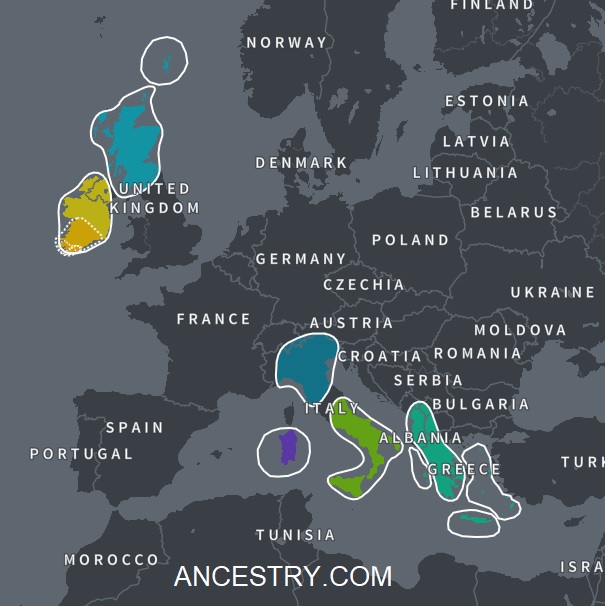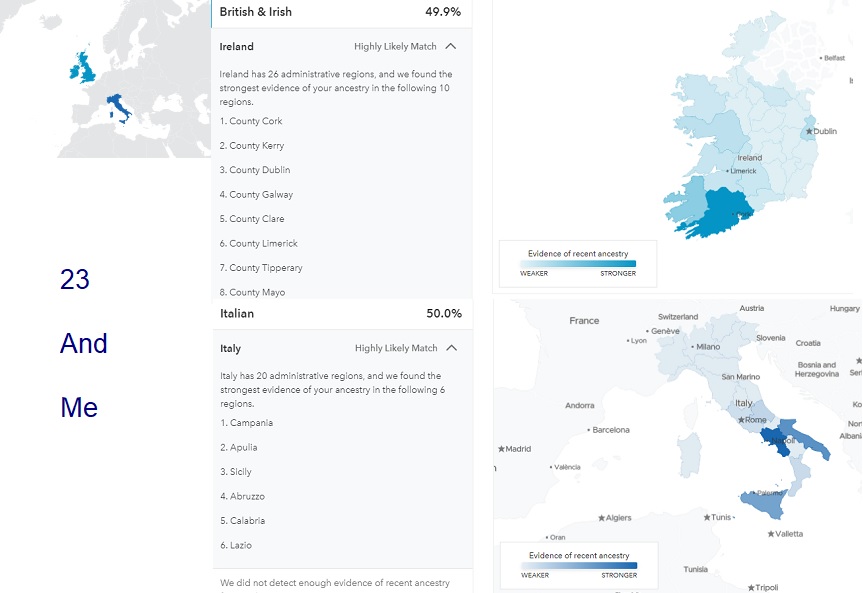The Basic Genetic Tests for Genealogy
This page may be embedded in an HTML frame. If so, be sure to utilize the vertical scroll bar on the HTML frame as well as the vertical scroll bar in your browser. On the right side of the browser window, the frame scrollbar should be left of your browser scrollbar.
Concepts: autosomal DNA, mitochondrial DNA, Y DNA. Why should you test? What are you trying to find out?
-
DNA is Deoxyribonucleic Acid. It is the molecular material making up our chromosomes in the nuclei of our body cells. It is the material that creates, repairs, and reproduces us. The specific proteins that constitute DNA are Adenine, Cytosine, Guanine, and Thymine. You will see these noted as A, C, G, and T.
-
Scientists examine human DNA for different reasons. Crime labs, for example, may look at DNA at an entirely different way than a medical doctor trying to advise a patient which in turn is different from the way a genealogist might look at data.
Any kind of DNA test involves examination of the sequences of the proteins that make up DNA and comparing those sequences to other DNA sequences.
-
For our purposes, we are looking at DNA only for ancestral research. The following family tree diagram shows the genetic tests you can apply to your family tree.

Y DNA: Blue diagonal line on the left: Surnames and Y-DNA (or yDNA) characteristically go together because fathers have historically passed on surnames to their children AND Y chromosomes ONLY to their sons. For the son, the Y chromosome and the surname are a package deal. The yDNA test looks only at those locations on the Y chromosome that might help carve out family groupings.

yDNA is stable over generations and has amazing longevity. There is no DNA level decision made on what gets passed down from father to son; the Y chromosome is replicated as accurately as possible under the reproduction circumstances. The Y chromosome is copied from father to son. What the son inherits is not random. Usually, the yDNA is a perfect copy, but sometimes there is a small change.
yDNA results reveal a genetic signature characteristic of that paternal line. Several men who are close relatives and share the same direct paternal ancestor will bear almost identical genetic signatures. The graphic shows parts of the genetic signatures of five men all bearing the same last name, whose families originated from the same rural location, and whose common ancestor probably lived in the latter part of the 18th century.

👉 Only men can take a yDNA test. 👈
👉 yDNA Surname studies work on the basis of that surname - Y DNA correlation. 👈
If you are a woman, that means you must get your father, brother, paternal uncle, paternal grandfather, or another male relative with the direct paternal ancestry you are studying to test. Surname projects want yDNA testers with a qualifying surname. Whether a surname project accepts other kinds of DNA tests without a Y test depends on the project.
MITOCHONDRIAL DNA: Pink diagonal line on the right: Mitochondrial (mtDNA) DNA tests direct maternal lines. There is no DNA level decision made on what gets passed down from mother to child; the mtDNA is replicated as accurately as possible under the reproduction circumstances. It's a straight copy passed down from mother to child. What the child gets is not random. Usually, the copy is perfect, but occasionally there is a slight change.
Mitochondrial (mito) DNA results reveal a genetic signature characteristic of that maternal line. Several people sharing the same direct maternal ancestor even within the last few thousand years could bear identical or near identical genetic signatures. The graphic shows parts of the mito genetic signatures of two people whose earliest known direct maternal ancestors were born late in the 18th century or early 19th century and who lived within about 20 miles of each other. The testers do not know how far back the common ancestry goes.

👉 Only women pass along mitochondrial DNA signatures. 👈
👉 Only daughters pass along the mitochondrial DNA of their mothers to their children. 👈
👉 Both men and women can take a mtDNA test. 👈
Like yDNA, mtDNA has amazing longevity over many generations.
AUTOSOMAL DNA: Pale orange triangular area covering the entire family tree: Autosomal DNA (autoDNA) testing (also called universal lineage testing) is a different kind of test. It can find relatives in ANY part of your ancestry. The unit used to measure relatedness is called a centiMorgan.
Unlike yDNA or mtDNA tests, which copy DNA from one generation to the next, what you inherit from your ancestors on the autosomes is subject to randomization. While you get half from your mother and half from your father, it is a "gene lottery" in terms of what you get from your grandparents, great-grandparents, etc.
autoDNA has the breadth that yDNA and mtDNA lack. The latter two tests target specific single lineages in your pedigree and go back many generations; autoDNA covers your entire lineage but it is reliable for only a few generations. So if it is possible, you should get members of your family in the older generations to test autoDNA. There are no name correlations.
Because of the randomization in what is inherited, it is a good strategy to test as many relatives as possible who share the same ancestry you are investigating, and the relatives you test should be in the oldest living generations possible.
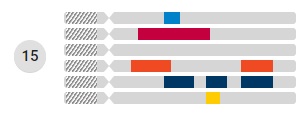
The graphic shows a chromosome tool through which one can view autosomal DNA matches. In this example, seven people sharing known common ancestry are illustrated on chromosome 15. (The six bars represent six matches to the tester.) Sometimes there is segment alignment or major overlap and sometimes there is not. Matching segments with two or more other testers are powerful evidence of common shared ancestry. Notice that one relative does not show anything at all on this chromosome when compared to the tester, even though he shares ancestry.
👉 Both men and women can take a autoDNA test. 👈
-
The following diagram of the human cell illustrates the sources of genetic material in your cells for these tests.

Green outline box, upper left: Autosomal DNA is the 22 pairs of chromosomes (autosomes) in the nucleus. Autosomal DNA testing taps those plus the X chromosomes from the sex pair. Women get two X chromosomes - one from her mother and one from her father passed to his daughter, intact from his mother. Men get just one X - from their mothers.
Pink outline box, left: At conception time, the ovum mitochondria prevail over sperm mitochondria in what gets passed down to a child, making it possible to trace maternal lines. The tester at the end point of that maternal lineage can be male or female. A man normally does not pass his mtDNA to his children.
Blue outline box, lower right: In males, the Y chromosome constitutes the second chromosome in the sex pair in the nucleus. They are XY. Females are XX.
-
The short answer is MAYBE.
DNA testing is still in its infancy. Compared to the number of people who could potentially test, relatively few have done so. It does not replace traditional genealogical research. It is another source of information but it can be a GOOD source. It can point you in certain directions that traditional genealogical records may not cover. DNA tests are tools, which have to be well understood to be used well.
Some people go into DNA testing knowing nothing about their ancestry. Maybe they were adopted or had a parent who was adopted. There are countless happy-outcome stories about people finding their birth parents or extended family through DNA testing. There are also not-so-happy stories and there are lots of people out there who have done DNA testing but remain at dead ends despite their efforts. There is a lot of luck involved with the matches you get and a lot of work involved in making sense of what matches you've got.
DNA testing will NOT conjure up non-existent genealogical records with the names and birth dates of the earlier ancestors in your pedigree. You would have to have a DNA match who knows that information and that information would have to be reliable. For a lucky few, testing will dump a family tree into their laps. For the vast majority of us, that is not the case.
The diagram below shows your pedigree, connected with thicker gray lines. Men are the dark blue dots; women are the dark pink dots.
Your autosomal DNA test will span that entire pedigree.
The extra three dashed blue lines coming from men represent direct male line descendancies. If you know of present day male relatives in those lines of descendancy, those are three Y DNA testing opportunities for you (besides yourself, if you are male) to establish the patriline genetic signatures in your pedigree. If you are female, the fourth opportunity is from your father, his full-blooded brother, your full-blooded brother, or your paternal uncle's son. If you are unsure of your research in a male line of descent, the independent tests of two males claiming direct patriline ancestry from the same ancestral male can be used to prove or dispute those claims.
The extra three dashed pink lines coming from women represent direct female line descendancies. If you know of present day relatives in those lines of descendancy, those are three mtDNA testing opportunities for you (besides yourself) to establish the matriline genetic signatures in your pedigree. If you are unsure of your research in a female line of descent, the independent tests of two people claiming direct matriline ancestry from the same ancestral female can be used to prove or dispute those claims.
When there are meaningful matches on a Y DNA or mtDNA test, the feeling is somewhat like what the prince felt when he found Cinderella, whose foot fit the glass slipper. It's a Eureka! moment. These are excellent tests to validate your genealogy research.
The recording of patriline and matriline genetic signatures in your pedigree should be as standard as the recording of birth, marriage, and death dates in your genealogy research.
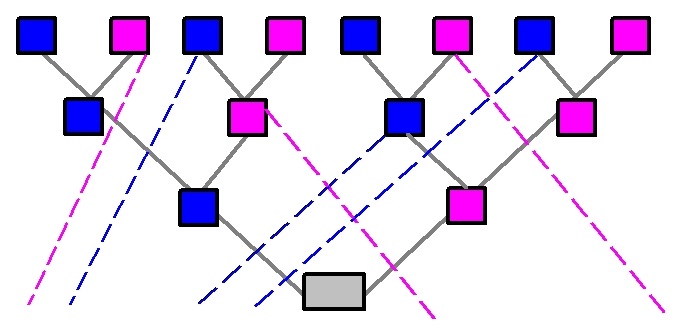
-
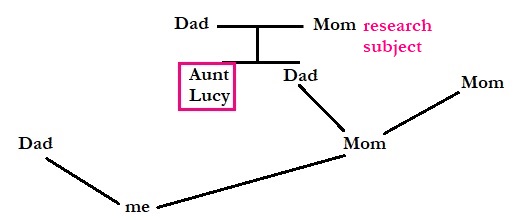 The family tree diagram illustrates the research problem. I put myself at the bottom ("me".) The other person available to test is labeled Aunt Lucy, who is the sister of Mom's Dad.
The family tree diagram illustrates the research problem. I put myself at the bottom ("me".) The other person available to test is labeled Aunt Lucy, who is the sister of Mom's Dad.If I take the mtDNA test, it will target my direct maternal line, which does not target my research subject in this particular case. My Mom did not get her mitochondrial DNA from her Dad. So, for this specific research target, my own mtDNA test will not help me.
I should have Aunt Lucy take the mtDNA test. Her mtDNA will capture the exact genetic signature of her mother, the research subject. Anybody who matches Lucy on the full mitochondrial test must share a common maternal line ancestor with her.
I should also have Lucy take the autosomal DNA test. Since she is 2 generations before mine, her autosomal DNA will be considerably less diluted than mine and will overall be more effective in matching her relatives and their descendants than my own autoDNA test.
I am descended from Lucy's brother, not Lucy. Lucy's brother probably passed down DNA to me through my Mom from the research subject.
Mom's Dad passed through without recombination an X chromosome from his Mom, the research subject, to my Mom. (See the next question for the implications.) However, Lucy's X chromosomes are "frozen" in her generation. Her X chromosome material from the research subject will have undergone less modification than through the path from her brother to my Mom to me. So there is considerably less to be gained by picking apart my X chromosomes for what X chromosome material I could have inherited from the research subject.
Mom's Dad (Lucy's brother) inherited DNA from the research subject that Lucy did not get. So the one outstanding reason for me to do the autoDNA test is that there is some chance I will match some of Lucy's relatives that Lucy herself does not match. Had I been directly descended from Lucy, it would not have been necessary for me to take the autoDNA test for the sole purpose of studying the research subject.
The Y DNA test on any male relatives will not be helpful in this case since the research subject is female.
-
Triangulation is the use of two known pieces of information to better understand a third piece of information common to the other two. While it is discussed a lot with autosomal DNA, it is utilized in other types of DNA matching.
Using autosomal DNA data, triangulation is the process of discovering matching DNA segments common to three or more testers. If two testers know how they are related and they have one or more matching DNA segments and they are related in ONE WAY, then those who share a matching segment, assuming it is of significant size, must share some of the common ancestry. If the first two testers are related in MORE THAN ONE WAY, the process of discovering how a common match is related may be more complicated.
Two Y DNA testers who know how they are related to each other might be able to figure out how a third match fits in their patriline. Similarly, two mtDNA testers who know how they are related to each other might be able to figure out how a third match fits in their matriline.
-
A woman recombines her X chromosomes prior to passing a new one to a child.
A man passes along his X chromosome from his mother to his daughter.
A girl gets a X chromosome from her father that came from her paternal grandmother, unaltered.
A daughter inherits an X chromosome from both her mother and her father. At conception time, the mother's own two X chromosomes undergo a recombination event to produce one X chromosome to pass to the daughter. The father does a straight-pass through of the X chromosome he got from his mother.
A son also receives a recombined X chromosome from his mother, but receives a Y chromosome from his father.
The passed-through X chromosome does not get ripped apart as rapidly in successive generations that alternate starting from the father: daughter, son, daughter, son, daughter, son, daughter, etc. During the daughter-to-son X transmissions, the surviving X chromosome material is subject to recombination. During the son-to-daughter transmissions, surviving X material gets passed through.
Some DNA segments on the X chromosomes could therefore survive longer before eventually getting split apart.
See: Unlocking the Genealogical Secrets of the X Chromosome, which also gives inheritance charts for males and females.
-
You will need to test at a lab that is match-enabled for the type of test you are considering.
Universal Lineage Test (Autosomal DNA)
Ancestry.com, Family Tree DNA (FTDNA), MyHeritage, 23AndMe, and Living DNA are match-enabled.
Ancestry.com and 23AndMe do not accept third party autosomal data transfers.
Ancestry.com, MyHeritage, and FTDNA have family tree editing features. Ancestry has features, based on the pool of family trees in its data resources, to make guesses about your ancestry. FTDNA has features by which if you link in known DNA matches into your family tree, the engine will tag other DNA matches sharing a significant matching segment, and by extension must share some of your ancestry.
23AndMe's family tree features, at the time of this writing, are extremely limited, and Living DNA does not yet family tree features.
All the labs below provide ethnicity results, though the number of reference populations used varies and continually changes.
All the labs below provide the ability to download your raw data for you to upload elsewhere.
All the labs below have you sign or mark informed consent and give you the ability to opt out of DNA matching.
FTDNA allows you to view matches without a subscription. (If you transfer data, you'll need to pay $19 to use some analytical tools.) Ancestry lets you view matches but you need a DNA subscription to view public trees. 23AndMe hard stops at 1500 matches unless you get the 23AndMe+ membership. MyHeritage requires a subscription $$$ to view ALL shared (in common with) matches.
In addition, there are third party venues, such as GEDMATCH and GeneaNet, which accept your autosomal DNA upload, enable autosomal DNA matching from multiple labs and have GEDCOM file upload features.
-
FTDNA is fully match enabled across its autosomal, Y DNA, and mitochondrial DNA test. There is an Advanced Matching feature which lets you check if another tester matches you on more than one test. This is illustrated in Part III of the tutorial.
-
Your autosomal DNA ethnicity results depend on the reference populations used by the testing labs.
For our purposes, a reference population for a region is not easy to define or pinpoint, but generally is a group of people claiming full ancestry from the region of interest and are expected to carry genetic "signatures" indicative of that population. Our knowledge of the characteristic genes for a population continues to get updated. One has to consider also that there is no such thing as a "pure" ethnicity. Southern Italy has been inhabited by other populations such as Greeks, Albanians, Spanish, French, Arabs and Africans. France has been inhabited by Celts, Germans and Scandinavians. England has had Celtic, French, German, and Scandinavian inhabitants. And so on. The complexities of our human history muddy the ethnicity waters.
All of the labs listed on this page continually improve their reference populations.
The screenshots below capture some of the 2020 ethnicity estimates from different labs based on the DNA results of a second genereration American with 50% known ancestry from west Cork in southern Ireland and 50% known ancestry from the Campania and Apulia regions of southern Italy.
ANCESTRY.COM
My Heritage
23 And Me
Living DNA
FTDNA
-
NO. The author does not get paid by any DNA labs or get special test discounts. She has to wait for good sales like everyone else.
-
The table below lists some good resources. There are also numerous groups on Facebook.
NO. You are likely to lose some match precision. Submitting a physical sample at the second lab in lieu of transfer of data is ALWAYS recommended, if you can afford to pay for the extra testing !
With transfers to FTDNA, the tutorial author has seen transferred DNA lose on the order of 80% of its match potential compared to the results obtained from doing a fresh test at FTDNA. Look at the graphic. The top row shows ALL, Paternal side, Maternal side, and Both side triangulated matches from an autosomal data FTDNA transfer account. The bottom row shows ALL, Paternal side, Maternal side, and Both side triangulated matches from a FTDNA swab account of the same individual. The transfer account shows a total of 602 matches; the swab account shows 4933 matches, a more than 700% increase! Or, you can say that the autosomal account has roughly 88% fewer matches than the swab account! The number of triangulated matches on both the Paternal and Maternal sides also increased by an order of magnitude.

If your budget is limited and you have transferred autosomal DNA to FTDNA, the author's recommendation is to not pay to unlock the autosomal tools with your transferred autosomal DNA (USD $19), then wait for a FTDNA sale and get a good price on doing the FTDNA test in a new, separate account. You might get it as low as $49, maybe even $39 during the year end sale. (Does not include cost of S&H the test kit, typically $13.) Typical sale times are the winter holiday (year end - best time); Valentine's Day; St. Patrick's Day, DNA Day (late April); Mother's Day (May); Father's Day (June) and the summer sale (August).
Furthermore, it is recommended that FTDNA transfer accounts be maintained separately from FTDNA swab accounts. If you mix autosomal transfer and swab for another test in the same account, you will lose your ability to use that submitted swab for FTDNA's autosomal test should you decide you want to improve your autosomal results. One account cannot keep two sets of autosomal results. Nor can you transfer a swab from one account to another. If you end up swabbing in two different accounts, you will lose the ability to use FTDNA's Advanced Matching feature on all your swab tests.
